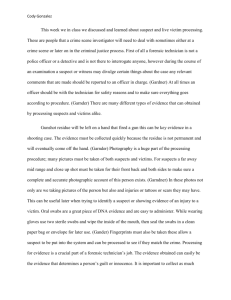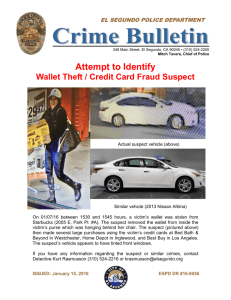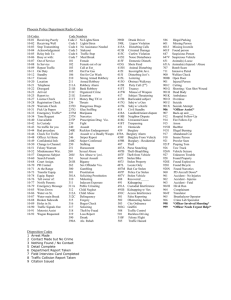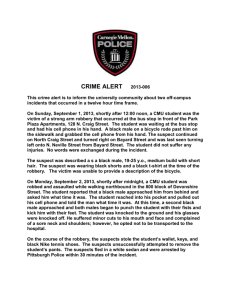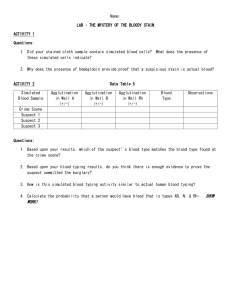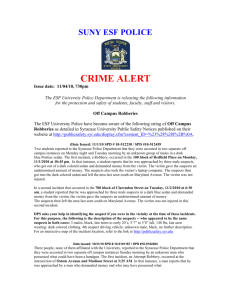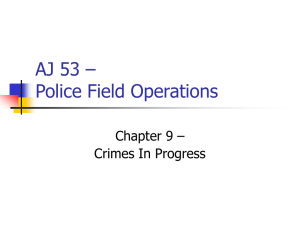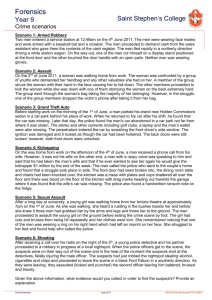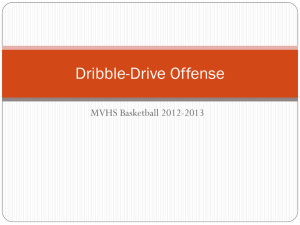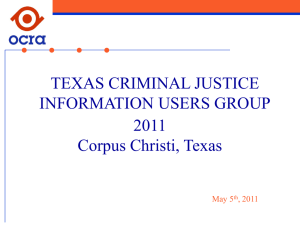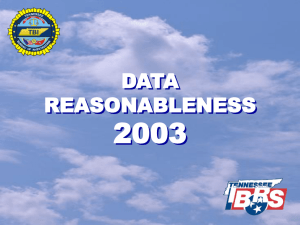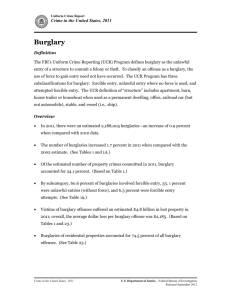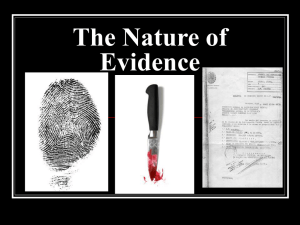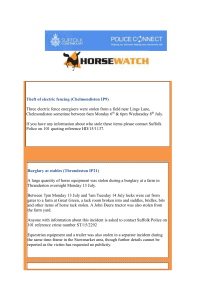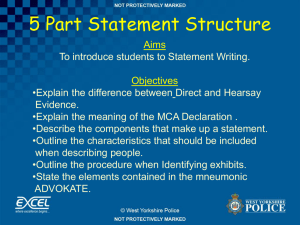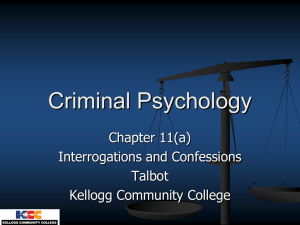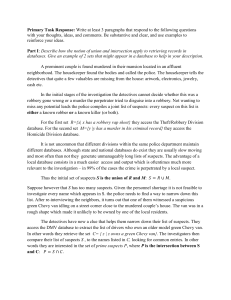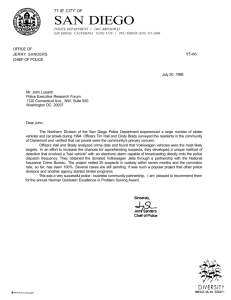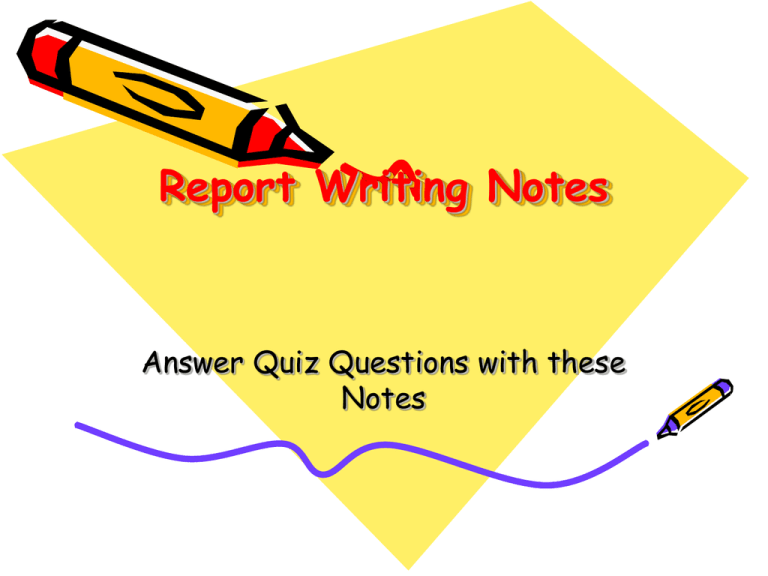
Report Writing Notes
Answer Quiz Questions with these
Notes
Warm up Connection
Nov 7 - 11
• Are you Open-minded? How?
Rationale
• The ability to write a good report can
make or break a case.
• A report that a police officer writes
in his squad car has the potential to
make it to the United States
Supreme Court.
Objectives
The student will be able to:
1. Define the different types of reports and
their functions.
2. Identify what makes a good police report.
3. Investigate a burglary case and write a report
on it.
4. Compose a report on an aggravated robbery
case as part of a multiple choice test.
Engage
• Ten items have been placed in a box
for you to observe
• Each student come up, one at a time,
using as much time as you need to
observe what is in the box.
• Students go back to their desk and
write what they observed.
Key Points
I. Observation
• An important skill in law enforcement.
• The better an officer observes things,
the better he or she can describe
them
II. The purpose of reports
in law enforcement
A. They provide a source of information while police
carry out an investigation
1. Allows passing of the case from one officer to
another
2. Provides a factual record of the work done on
a case, eliminating duplication
3. Is a requisite for the proper preparation and
presentation of a case to the district attorney
and to the court
B. Helps a department
stay organized
1. The memory system of a department
2. Serves as a written, permanent
record of all department business
C. A report is an
administrative necessity;
most official forms of
communication are
completed using reports.
D. Other purposes
1. The basis for
maintenance of
identification and
criminal records in
Austin
2. Aid in the recovery of
lost or stolen property
3. Contain information
used to apprehend
criminals
4. Used in civil suits
5. Provide factual data
to combat ill-advised
or unreasonable
demands on police
6. Furnish information to
the news media
III. Types of reports
A. Initial reports – can begin in the
squad car and end up in the
Supreme Court
1. Arrest reports
2. Incident reports – for documentation
purposes only
3. Offense reports – begin the investigation
of criminal matters
4. Initial reports – written by the assigned
officer, covering the initial investigation,
and lay the foundation for the whole case
B. Supplemental reports
1. All reports other
than the initial
report
2. Written by an
officer, other than
the one assigned,
about his or her
participation in a
particular case
3. Concerned with
follow-up work
performed by
inspectors, detectives,
or investigators
4. Submitted in
connection with the
investigation by
specialists such as
fingerprint
technicians,
photographers, drug
lab analysts, etc.
C. Attachments to reports
including crime scene
photos and sketches, notes,
and other documents filed
with the case report
IV. Styles of reports
A. Narrative
1. Most widely used
2. Information written in a logical
manner or sequence
B. Chronological
1. Events written in order of
occurrence
2. Time element is of prime importance
C. Specialized
1. Summary of reports about
specialized law enforcement and
police problems
2. May be either narrative,
chronological, or both
V. Essential qualities of a
report
A. Clear and complete sentences
B. Proper grammar
C. Detailed descriptions
VI. Rules for description
A. Describe things
without assuming.
B. Use vivid language.
C. Look for distinguishing
marks, color, size,
shape, texture,
location, type, etc.
D. Paint a picture of a place
with words.
E. Describe people from top
to bottom and include
characteristics such as
manner of speaking,
walking, moving, items they
are carrying, etc.
F. Four Corners Rule – if it's
not within the four corners
of the paper then it did
not happen
VII. Four requisites of a
good report
A. Factual – detailed correctness
B. Clear – distinct and unconfused
C. Complete – having no deficiency
D. Concise – expressing much in a few
words
VIII. Questions to ask
and answer
A. Who?
B. What?
C. When?
D. Where?
E. Why?
F. How?
IX. Essential components
of a report
A. Date
B. Time
C. Location
D. Kind of call
E. Description of
surroundings
F. Description of
vehicle
G. Description of
suspect
H. Chronological
order
X. Preparing for the
report
A. Organize your evidence and
information
B. Check with dispatch for updated
data
C. Log in the evidence
D. Begin the report
XI. Writing the report
A.First Section
1. Type of call
2. Case number
3. Date and time of the report
4. Date and time of the offense
5. Type of report (offense or incident)
XI. Writing the report
6. Caller information (name, date of birth,
race, sex, hair and eye color, height,
weight, driver’s license number)
7. The complete victim or complainant
address and phone number
8. The victim or complainant’s employer
9. Location of the offense
10. Who it was reported by (complete information)
XI. Writing the report
11. Employer contact information
12. Number of witnesses, number of suspects, etc.
13. The incident or offense
14. Probable cause or “MO”
15. The report writer
16. Supervisor’s approval
17. Stolen property entered by dispatch into the
computer (over $2000 value only, or stolen
vehicles)
B. Vehicle or evidence
information
1. Vehicle listing (stolen, recovered,
abandoned, etc.)
2. Vehicle type (make, model, year, license
plate, state of registration, VIN)
3. Value
4. Condition
5. Other Remarks
C. Weapons description
1. Quantity
2. Appearance
3. Caliber
4. Serial Number
5. Model
6. Value
D. Burglary information
1. How the suspect entered the home
a. Home accessible (unlocked)
b. Forced entry
c. Inside job
2. How the suspect left the home
E. Summary
1. Restate the probable cause or
“MO” (see example).
2. State whether dispatched or on
view.
3. Describe the crime scene.
4. Tell the story.
E. Summary
5. Identify yourself as the reporting
officer (R/O) (not your name).
6. Use R/O for the rest of the report.
7. Identify the victim, suspect, and
witnesses in the report.
8. Take pictures of everything.
9. No pronouns used
Activity # 1
•
Burglary case
Students hear “The Burglary
Case”
• Students take notes.
• Students ask the
instructor questions
related to the crime.
• Students then fill out a
report and write a
narrative based on the
notes they have taken
about the crime.
4.
The report must include:
–
–
–
–
–
–
–
–
–
5.
Address
Time of day
Detailed description of the scene
Suspects
Suspect vehicle
Property taken
Detailed accounts of the
witnesses’ and victim’s stories
How the suspects approached
and departed the scene
How are the suspects entered
into the system as stolen.
It must have creative aspects
and be at least one page in
length.
Activity # 2
Students create scenarios for the
other students to write a report
Assessment
• Notes Quiz
• Technical Report Writing Exam


